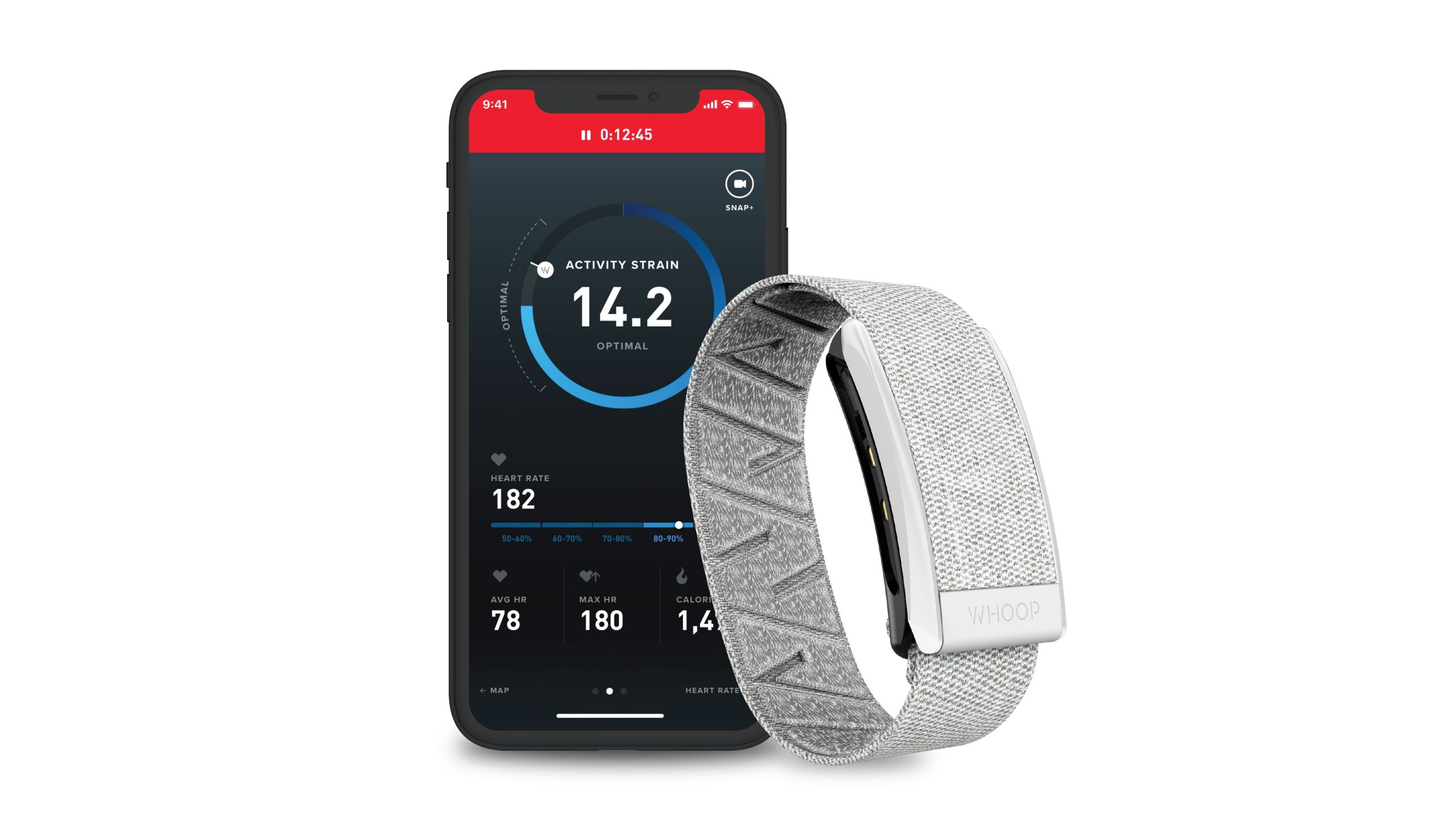
REVIEWER: DR DAVID LIPMAN
WHOOP, there it is … Nineties music references aside, the feeling I could not escape as WHOOP and its bands came across my social media timeline is a product of both their marketing and the world we live in.
To elaborate on these two aspects and their intersection a little more; we have never been more advertised to in an overt manner but also in a less overt manner with influences, affiliates and sponsored athletes becoming the new billboards. Furthering this is the continuously progressing “quantified self” movement, and the cherry on top is the COVID-19 global pandemic.
As someone interested in this space yet also quite anal on some detail, I can be quite the sceptic when it comes to technology, despite my love for it. This is predominantly born out of the view that technology cannot replace our intuition and experience when it comes to knowing/learning about our bodies but also the frustration I see with the use of surrogate measures to draw big outcome measures in technology. This provides the necessary context for the battle I have seen unfolding slowly but steadily, more recently rapidly, in the “quantified self” space between the two big hitters in the wearables space: the Oura Ring and WHOOP.
In a very much tit for tat battle, Oura rings were given to all NBA players in the NBA finals bubble, while WHOOP straps adorned NFL players, CrossFit games athletes and many PGA players. Oura made its way on the fists of the UFCs fight island athletes, while WHOOP threw up the hammer and axe in a collaboration with the Tin Man Elite running team. Oura sat on Peter Attia’s finger while WHOOP adorned Joe Rogan’s wrist. All the while, both companies worked hard to participate in the academic research space, with both attempting to verify their tracker as reliable for sleep monitoring, as well as both participating in COVD-19 research to indicate early detection. Perhaps of greatest interest to me on a personal level, though, was WHOOP’s work looking at burnout in medical residents in the USA, an area I think has great promise, most notably if said residents are looking at any sort of athletic performance.
So then, what was wearing a WHOOP strap like and is it worth it?
At its core WHOOP is an optical heart rate monitor that works to help you balance strain (HR predominantly) and recovery (sleep, resting HR and HRV). If you understand this, you understand a few things: the value lies in the algorithms/machine learning, not in the strap. The strap measures cardiovascular stress quite well but falls short on other things (like stress from weightlifting). The strap and service struggle with the limitations of optical heart rate monitors, and the strap replaces nothing you already own.
HEART RATE (HR)
This is the core measurement from which most things WHOOP uses are derived (everything except accelerometers, which measure/account for your movement). Given this, the accuracy of the HR measurement is paramount to the insights of the technology being meaningful. The technology for optical heart rate is good tech but with many challenges and limitations. In general, I think WHOOP does a good job with its strap to minimise these: there is no bounce, water/sweat doesn’t seem to impact things, and it almost always gets a good trace of heart rate. Unfortunately, as can be the case with optical HR and some algorithms, the strap seems to perform less accurately with quick changes in heart rate and/or short intervals in training. It tends to underestimate maximum heart rate in general during activities with a heart rate >180bpm.
SLEEP
Using data from HR and its accelerometers. Using these measures, it calculates sleep stages with a mixture of HR, movement and respiratory rate (derived from HR).
While it’s difficult to be certain, as I have nothing to compare it to, I feel like WHOOP overestimates my awake time during the night. That said, these micro awakenings/disturbances may not be as they are labelled but may be valuable information nonetheless, given on nights where I sleep well, I have fewer of them. The studies that have looked into WHOOP as a sleep tracker suggest it has good accuracy.
STRAIN
Uses heart rate to talk about strain across the day. This somewhat split into activity strain and other strain but mostly it is lumped together. Each activity accrues strain, as does living.
HEART RATE VARIABILITY (HRV)
This is measured continuously but the component used for your HRV tracking/measurement that you see each day is your HRV in the last period of slow-wave sleep (likewise your resting heart rate). The reason given for this is that the body does its physical repair and recovery during slow-wave sleep, so this gives the best indication of recovery status.
RECOVERY
This is given as a percentage and drawn from a mixture of measures. WHOOP explains that it is derived from your resting HR, HRV and sleep. From my experience, I would suggest the biggest factor in this is HRV, but this could be my perception, and WHOOP does not distinguish the impact of each.
Key Concept:
Your body only understands stress, not the source of stress. The more stress you undergo, the more recovery is needed. An imbalance between stress and recovery causes overtraining, burnout or similar. The more life stress you have and/or worse recovery you have, the less stress from training you can tolerate.
Cool bits:
Autodetection
This is where machine learning gets unbelievably cool and kind of eery. Activities are autodetected from an elevated heart rate for 15 minutes or more. You can then input what that activity was. But after a little while, WHOOP auto-detected my running as running, not an activity to be labelled … very cool. You can also insert activities manually, which includes things like naps, and edit activities for length, etc. The strap also autodetects sleep.
Sleep Coach
Effectively, this is a function that uses machine learning and sleep hygiene advice to prompt you on how to get the best sleep to aid recovery. It advises on a bedtime using your normal sleep patterns and quality, as well as sleep need (calculated based on normal requirements plus strain).
Strain Coach
Based on recovery scores, an optimal level of strain for the day is recommended in order to balance your strain and recovery. Going beyond this allows for overreaching (the means by which you gain fitness); going below this promotes recovery. The strain coach is a live function that allows you to push to the point of optimal strain as advised in real time.
Performance Assessments
These are for different timeframes (weekly or monthly) and look at your day strain versus recommended day strain. This effectively looks at whether you are working hard on days where you are more recovered or not. I think this has some real potential in the medium to long term to really help inform training.
The monthly performance assessments are where things get SUPER helpful. Patterns across the month are shown and insights are drawn from your habits tracked via the journal (for example, when you drink alcohol or caffeine, what happens to your sleep, HRV, etc.). I think this has a huge potential to drive insights and behaviour change. Currently, the journal (which is where you input behaviours, including the aforementioned and other things like meditation) has 40 behaviours but given the recent $100 million (USD) round of funding and statements from the CEO, I would suggest features like this will continue to grow and evolve.
If I was to have to indicate the most valuable and/or useful part of the service, this is it hands down. It is also what sets WHOOP apart from other sleep trackers.
The app:
Perhaps unsurprisingly, the app runs really well and is very user friendly. Aside from giving great insights, the app provides regular advice on and explanations of your personal measurements. The team at WHOOP does a great job of answering user questions, often with a link for you to read about a metric and what goes into it.
Key points:
Weight of strap: Negligible.
Cost: Subscription model, variable rates depending on a few things, best to check for yourself.
What is measured? Heart rate and movement, which then gives the metrics: HRV, Sleep, “Strain” (a measure of cardiovascular work), respiration rate.
Point(s) of difference: Machine learning-based algorithms. These get better with time and focus on insights around certain things you can input, ie. dietary habits, caffeine intake, etc. These also attempt to give you advice on sleep and training.
Waterproof: Strap is, but battery pack is not.
Charging/Battery: Strap has a five-day battery life with 24-hour/day use. There is a battery pack that slips on over the strap to charge it (takes <60 minutes). The battery pack is charged via USB in 90-120 minutes.
Fashion: I admit I am not a particularly fashionable guy, but there are many customisable options for the strap, which are cool. You can also get accessories like a bicep strap and impact sleeves if you are doing things like contact sports. There have been some really cool collaborations in this area to support causes, as well as brand partnerships.
What’s the role of using WHOOP and who should use it:
Despite my love for tech and gadgets, I will reiterate that I don’t think solely basing training decisions on any tech-derived metric is the way to go. That said, I would be interested in trialling a period where the timing of some sessions was modified by the use of WHOOP. For example, pushing back a hard interval session on a day with poor recovery.
Beyond this, using WHOOP made me a little more aware of things like bedtimes, wake times, etc., than I was. To be honest, I am fairly meticulous with this already but found myself maybe 5% moreso. I am also the guy who stopped wearing a step tracker due to becoming a little too focussed on it, so I do have that tendency to want to optimise. I think this gives insight into the fact that it may help those who are a little more lax on sleep hygiene or struggle with sleep in general (though, this can be a double-edged sword, as we are seeing more and more in the wearable space).
I think there is a big role for WHOOP for those who are struggling to understand their body and need some objective measurements to help. Additionally, I think those who are trying to tread the fine line of training stress but are impacted by significant other factors in their lives – for example, high-stress jobs, strange working hours, and/or new parents.
Dr David Lipman is a podiatrist, exercise physiologist and medical doctor who doesn’t make it to trails as often as he’d like, drinks too much coffee and is a big believer in first principles and understanding the basics, in tech and training alike. Contact him on Instagram @dlipman5 or via email at dj_lipman@hotmail.com.







